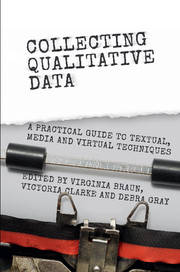Book contents
- Collecting Qualitative Data
- Collecting Qualitative Data
- Copyright page
- Contents
- Figures, Tables and Boxes
- Acknowledgements
- Contributors
- Foreword
- 1 Collecting Textual, Media and Virtual Data in Qualitative Research
- Part I Textual Data Collection
- Part II Media Data Collection
- Part III Virtual Data Collection
- Afterword
- Glossary
- Index
- References
Part III - Virtual Data Collection
Published online by Cambridge University Press: 06 October 2017
- Collecting Qualitative Data
- Collecting Qualitative Data
- Copyright page
- Contents
- Figures, Tables and Boxes
- Acknowledgements
- Contributors
- Foreword
- 1 Collecting Textual, Media and Virtual Data in Qualitative Research
- Part I Textual Data Collection
- Part II Media Data Collection
- Part III Virtual Data Collection
- Afterword
- Glossary
- Index
- References
Summary

- Type
- Chapter
- Information
- Collecting Qualitative DataA Practical Guide to Textual, Media and Virtual Techniques, pp. 189 - 210Publisher: Cambridge University PressPrint publication year: 2017
References
Further Resources: Online
The Research Ethics Guidebook is a resource for social science researchers; for students, it provides help with writing a research proposal or ethics application and dealing with ethical dilemmas: www.ethicsguidebook.ac.uk
The British Psychological Society provides ethical guidance for Internet-mediated research: www.bps.org.uk/&/inf206-guidelines-for-Internet-mediated-research.pdf
Further Resources: Readings
References
Further Resources: Online
For an introduction to what IM is, see https://en.wikipedia.org/wiki/Instant_messaging
Further Resources: Readings
To read more about the example studies involving couple interviews, see
References
Further Resources: Online
Skype: www.skype.com/en/
Further Resources: Readings
References
Further Resources: Online
The following websites provide information for young people about online safety: Stay Safe Online.org: www.staysafeonline.org/stop-think-connect/tips-and-advice
Safety Net Kids – staying safe online: www.safetynetkids.org.uk/personal-safety/staying-safe-online/

